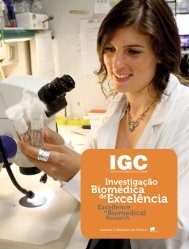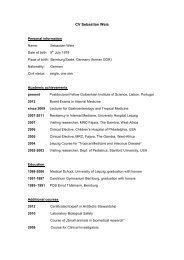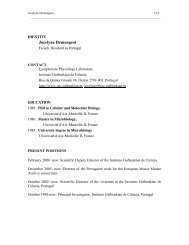organisation - the Instituto Gulbenkian de Ciência
organisation - the Instituto Gulbenkian de Ciência
organisation - the Instituto Gulbenkian de Ciência
- No tags were found...
Create successful ePaper yourself
Turn your PDF publications into a flip-book with our unique Google optimized e-Paper software.
EVOLUTION<br />
AND DEVELOPMENT<br />
Élio Sucena Principal Investigator<br />
PhD in Evolution and Development, Genetics, Cambridge, UK, 2001<br />
Post-Doc at Princeton University, USA<br />
Post-Doc at University of Western Ontario, Canada<br />
Liaison with <strong>the</strong> Champalimaud Foundation<br />
Principal Investigator at <strong>the</strong> IGC since 2003<br />
Research in my lab focuses on evolutionary novelties, <strong>de</strong>fined as a novel body<br />
part that is nei<strong>the</strong>r homologous to any body part in <strong>the</strong> ancestral lineage nor<br />
serially homologous to any o<strong>the</strong>r body part of <strong>the</strong> same organism. This concept<br />
can be exten<strong>de</strong>d to o<strong>the</strong>r traits, for example, physiological or behavioural.<br />
We have i<strong>de</strong>ntified several instances of novelty, as <strong>de</strong>fined above, that we are<br />
experimentally dissecting:<br />
1. At <strong>the</strong> genetic level, looking at gene function evolution upon gene duplication;<br />
2. At <strong>the</strong> cellular level, approaching immune cell function diversity in Drosophila;<br />
3. At <strong>the</strong> morphological level by studying <strong>the</strong> evolutionary origin of dorsal<br />
appendage formation in <strong>the</strong> Drosophila cla<strong>de</strong>.<br />
DISSECTING THE DEVELOPMENTAL GENETIC BASIS OF EVOLUTIONARY NOVELTY<br />
The eggshell's dorsal appendages are structures unique to <strong>the</strong> Drosophila lineage,<br />
found throughout <strong>the</strong> lineage in various numbers, shapes and sizes. With<br />
Adrien Fauré and Claudine Chaouiya we have progressed in <strong>the</strong> establishment<br />
of a mo<strong>de</strong>l that recapitulates <strong>the</strong> epi<strong>the</strong>lial patterning, and with which we are<br />
now able to explore <strong>the</strong> variation in number this structure displays across Drosophila<br />
species. In addition, our research into eggshell patterning of Ceratitis<br />
capitata, a species without dorsal appendages outsi<strong>de</strong> of <strong>the</strong> Drosophila cla<strong>de</strong>,<br />
has led to a renewed un<strong>de</strong>rstanding of <strong>the</strong> role played by <strong>the</strong> Dpp pathway<br />
during oogenesis. With <strong>the</strong> combination of <strong>the</strong>se two lines of research we continue<br />
to investigate both <strong>the</strong> possible origin as well as <strong>the</strong> diversification of this<br />
evolutionary novelty.<br />
GROUP MEMBERS<br />
Nelson Martins (Post-doc)<br />
Kohtaro Tanaka (Post-doc, started in May)<br />
Alexandre Leitão (PhD stu<strong>de</strong>nt)<br />
Barbara Vree<strong>de</strong> (PhD stu<strong>de</strong>nt)<br />
Vítor Faria (Research Assistant)<br />
COLLABORATORS<br />
Jen Sheen (Massachusetts General Hospital, USA)<br />
Mark Borowsky (Massachusetts General Hospital, USA)<br />
Brad Chapman (Massachusetts General Hospital, USA)<br />
Ignacio Rubio Somoza, (Max Planck Institute for Developmental Biology,<br />
Germany)<br />
Detlef Weigel (Max Planck Institute for Developmental Biology, Germany)<br />
Pedro L. Rodriguez Egea (<strong>Instituto</strong> <strong>de</strong> Biología Molecular y Celular<br />
<strong>de</strong> Plantas, Universidad Politécnica <strong>de</strong> Valencia, Spain)<br />
Markus Teige (Max F. Perutz Laboratories, Univ. Vienna, Austria)<br />
Andreas Bachmair (Max F. Perutz Laboratories, Univ. Vienna, Austria)<br />
Claudine Chaouiya (IGC, Portugal)<br />
Adrien Fauré (IGC, Portugal)<br />
Thiago Carvalho (IGC, Portugal)<br />
Jocelyne Demengeot (IGC, Portugal)<br />
Luis Teixeira (IGC, Portugal)<br />
Fernando Roch (Centre <strong>de</strong> Biologie et Developpement, France)<br />
Sara Magalhães (Faculda<strong>de</strong> <strong>de</strong> Ciências, Universida<strong>de</strong> <strong>de</strong> Lisboa, Portugal)<br />
FUNDING<br />
Fundação para a Ciência e a Tecnologia (FCT), Portugal<br />
<strong>Instituto</strong> <strong>Gulbenkian</strong> <strong>de</strong> Ciência (IGC), Portugal<br />
Comparing <strong>the</strong> patterning network of Drosophila with a species without dorsal<br />
appendages, <strong>the</strong> mediterranean fruitfly Ceratitis capitata, has pointed us<br />
toward a key no<strong>de</strong> in <strong>the</strong> network: <strong>the</strong> gene mirror. This transcription factor is<br />
absent in Ceratitis oogenesis, but performs a key function in <strong>de</strong>fining <strong>the</strong> cells<br />
that make up <strong>the</strong> dorsal appendages, as well as <strong>de</strong>fining <strong>the</strong> dorso-ventral axis<br />
of <strong>the</strong> future Drosophila embryo. We are currently exploring this co-option in<br />
more <strong>de</strong>tail.<br />
FUNCTIONAL EVOLUTION UPON GENE DUPLICATION<br />
We have been studying a recently expan<strong>de</strong>d gene family in Drosophila, <strong>the</strong><br />
Three Finger Domain Protein (TFDP), in particular <strong>the</strong> nine genes of clusters III<br />
and V. Given <strong>the</strong>ir expression patterns in <strong>the</strong> Drosophila eye disc, we hypo<strong>the</strong>sise<br />
that, in higher Diptera, TFDP genes have been co-opted by <strong>the</strong> ancestral<br />
eye <strong>de</strong>velopment gene network. Different genes of this recently expan<strong>de</strong>d family<br />
have been <strong>de</strong>ployed in specific glial/neural cell subsets as to participate in<br />
<strong>the</strong> highly dynamic process leading to <strong>the</strong> formation of both photoreceptor<br />
axonal tracks and <strong>the</strong>ir respective myelin sheaths. This study establishes <strong>the</strong><br />
TFDP gene family evolution as an example of neo/sub-functionalisation by gene<br />
duplication. Fur<strong>the</strong>r work will clarify <strong>the</strong> specific impact of regulatory evolution<br />
over <strong>the</strong> gene network driving <strong>the</strong> cellular mechanisms in <strong>the</strong> <strong>de</strong>veloping eye of<br />
holometabolous insects.<br />
In or<strong>de</strong>r to have a comprehensive <strong>de</strong>scription of expression pattern evolution<br />
of <strong>the</strong>se nine TFDP genes in Drosophila, we exten<strong>de</strong>d our analysis to Tribolium,<br />
Anopheles, Megaselia and Ceratitis. With this wi<strong>de</strong> phylogenetic coverage, we have<br />
a clear i<strong>de</strong>a of <strong>the</strong> duplication history of <strong>the</strong>se genes and hence a strong basis to<br />
<strong>de</strong>fine instances of sub- and neo-functionalisation for future promoter dissection.<br />
IMMUNE CELL FUNCTION DIVERSITY IN DROSOPHILA<br />
We had previously shown that, contrary to <strong>the</strong> current view, Drosophila plasmatocytes<br />
(<strong>the</strong> functional analogues of vertebrate macrophages) constitute a<br />
heterogeneous population. For this we have established a novel protocol for<br />
PARASITOID WASP EGG SURROUNDED BY HOST IMMUNE CELLS (PLASMATOCYTES).<br />
Heterogeneity of plasmatocyte population is apparent by <strong>the</strong> differential expression<br />
of green (Cg25C) and red fluorescence (eater).<br />
IGC ANNUAL REPORT ‘11<br />
RESEARCH GROUPS<br />
62






